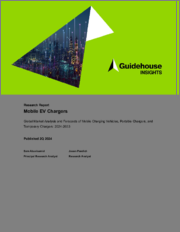
|
시장보고서
상품코드
1477958
이동식 EV 충전기 : 이동식 충전 차량, 휴대용 충전기, 일시 충전기의 세계 시장 분석과 예측(2024-2033년)Mobile EV Chargers - Global Market Analysis and Forecast of Mobile Charging Vehicles, Portable Chargers, and Temporary Chargers, 2024-2033 |
||||||
플러그인 전기자동차(PEV)의 보급과 함께 강력한 전기자동차 충전 생태계가 필요하며, PEV의 초기 도입자들은 대부분 가정용 충전기로 충전 수요를 충족시켜 왔지만, PEV의 보급이 증가함에 따라 공공 충전 솔루션에 대한 수요도 증가할 것으로 예상됩니다. 영구적으로 설치된 충전기는 대부분의 충전 수요를 충족시킬 수 있지만, 송전선로 용량의 한계, 높은 전력망 갱신 비용, 충전기 설치 지연으로 인해 충전 생태계에 공백이 발생합니다. 이러한 격차를 해소하기 위해 이동식 전기자동차 충전기는 유연한 임시 충전 솔루션을 구축할 수 있습니다.
이동식 EV 충전기는 배터리 팩이나 발전기를 사용하여 PEV에 충전을 제공하는 EV 충전 시장의 작은 부분으로, 충전 차량, 휴대용 충전기 및 임시 충전기를 포함합니다. 이동식 EV 충전기는 쉽게 이동할 수 있고 전력망에 영구적으로 연결하지 않고도 작동할 수 있으므로 온디맨드 및 도로변 보조용으로 사용할 수 있습니다. 또한 단기적인 수요를 충족하거나 비상시 충전을 제공하거나 상설 충전기 설치 후보지의 상업적 잠재력을 평가하기 위해 반 영구적으로 배치할 수도 있습니다.
세계의 이동식 EV 충전기 시장 동향에 대해 분석했으며, 전체적인 판매 대수와 매출의 동향 전망(2024-2033년) 및 기술별(충전 차량, 휴대용 충전기, 일시 충전기 등)·컴포넌트별(배터리, 비배터리)·지역별 상세 동향, 신규 판매되는 이동식 EV 충전기의 잠재적 설치용량과 배치 대수 전망 등을 조사하여 전해드립니다.
목차
제1장 주요 요약
제2장 시장의 문제
- 서론
- 이동식 EV 충전기
- 충전 차량
- 휴대용 충전기
- 일시 충전기
- 촉진요인
- 로드사이드 지원과 온디맨드 충전
- 단기·긴급 배치
- 현장에서의 평가
- 항구적인 설치의 대체
- 억제요인
- 충전기 관리
- 배터리 용량
- 환경에 대한 우려
- 기술개발
제3장 산업 밸류체인
- 서론
- 밸류체인 도해
- 경쟁 구도
- 기업인수합병(M&A) 활동
- 비즈니스 모델의 진화
제4장 시장 예측
- 조사 범위
- 조사 방법
- 주요 전제조건과 제한사항
- 제한
- 세계 시장의 분석 결과
- 매출
제5장 결론·제안
- 3대 포인트
- 권장사항
- 배터리 공급업체
- EVSE(EV용 충전소) 제조업체
- 자동차 OEM·딜러
- 공공 충전 서비스 프로바이더
- 플릿 오퍼레이터
- 직장·MUD(다세대주택) 오너
제6장 두자어·약어 리스트
제7장 목차
제8장 도표
제9장 조사 범위, 정보원과 조사 방법, 주석
KSA 24.05.22The growing number of plug-in EVs (PEVs) on the road will require a robust EV charging ecosystem. Most early adopters of PEVs have satisfied their charging needs with home chargers, but as PEV adoption increases so will the need for public charging solutions. Permanently installed chargers can serve most charging needs, but limitations to grid capacity, high costs for grid upgrades, and delays in charger installations will create gaps in the charging ecosystem-gaps that can be filled by mobile EV chargers, which can provide a flexible and temporary charging solution.
Mobile EV chargers, which are a small segment of the EV charging market that utilize battery packs or generators to provide charging to PEVs, include charging vehicles, portable chargers, and temporary chargers. Because mobile EV chargers can be easily transported to a location and operate without a permanent grid connection, they can be utilized for on-demand and roadside assistance. They can also be deployed on a semipermanent basis to help satisfy short-term demand, provide charging during emergency situations, or evaluate the commercial viability of a potential site for permanent chargers.
This Guidehouse Insights report includes forecasts from 2024 to 2033 for the sales and revenue of mobile EV chargers segmented by technology: charging vehicles, portable chargers, and temporary chargers. Revenue projections for each technology are segmented into battery and non-battery components. The potential battery capacity for new mobile EV charger sales and the total population of deployed chargers are also included.
Table of Contents
1. Executive Summary
- 1.1 Introduction
- 1.2 Scope
- 1.3 Market Outlook
2. Market Issues
- 2.1 Introduction
- 2.2 Mobile EV Chargers
- 2.2.1 Charging Vehicles
- 2.2.2 Portable Chargers
- 2.2.3 Temporary Chargers
- 2.3 Drivers
- 2.3.1 Roadside Assistance and On-Demand Charging
- 2.3.2 Short-Term and Emergency Deployments
- 2.3.3 Site Evaluation
- 2.3.4 Alternative to Permanent Installation
- 2.3.4.1 Avoided Grid Constraints
- 2.3.4.2 Load Management
- 2.3.4.3 Nonpermanent Users
- 2.3.4.4 Avoided Permitting Costs
- 2.3.4.5 Incentives
- 2.4 Barriers
- 2.4.1 Charger Management
- 2.4.2 Battery Capacity
- 2.4.3 Environmental Concerns
- 2.4.3.1 Power Generation Concerns
- 2.4.3.2 Battery Production Concerns
- 2.4.4 Technological Developments
3. Industry Value Chain
- 3.1 Introduction
- 3.2 Pictorial Representation of the Value Chain
- 3.3 Competitive Landscape
- 3.3.1 Merger and Acquisition Activities
- 3.3.2 Business Model Evolution
4. Market Forecasts
- 4.1 Scope
- 4.2 Methodology
- 4.3 Key Assumptions and Limitations
- 4.4 Limitations
- 4.5 World Market Results
- 4.5.1 Revenue
5. Conclusions and Recommendations
- 5.1 Three Big Takeaways
- 5.2 Recommendations
- 5.2.1 Battery Suppliers
- 5.2.2 EVSE Manufacturers
- 5.2.3 Vehicle OEMs and Dealerships
- 5.2.4 Public Charging Service Providers
- 5.2.5 Fleet Operators
- 5.2.6 Workplace and MUD Owners



















